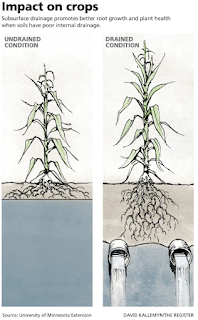The Natural Resources Conservation Service (NRCS) in Iowa has been working towards all watersheds in Iowa having watershed assessments performed via the Rapid Watershed Assessment (RWA) method. The goal is to efficiently and effectively assess each of Iowa's watersheds to then put the results in the hands of those making decision (i.e. local managers/governments). As such, I will be discussing the tools used for the RWA assessment. Within each assessment, the following topics are generally addressed: Land use/cover, physical resources, water quality report, soil, stream, precipitation data, census/social data, resource concerns, progress/status of conservation by land use and estimated future projects and associated costs.
The image below depicts those watersheds that are either in progress, outlined in red or completed, outlined in black.
(Image source: USDA NRCS Iowa; https://www.nrcs.usda.gov/wps/portal/nrcs/ia/technical/dma/rwa/)
Based on this image, the south fork of the Des Moines River Watershed has not been evaluated to date.
What is interesting about the current progress on the RWAs according to the NRCS website, is that the first one was published in October of 2007 and the latest one was published in October 2012. They did mentioned on the website that this was a five year project, so I'm curious if they used all of their funding on the watersheds already surveyed.
**Update** - I connected with an Iowa USDA NRCS representative about the RWA. The intent was never for NRCS to cover all of the watersheds in Iowa, but to empower and enable other groups to be able to put together high quality reports to express the needs for watershed projects.
As there already is a plan in place, I am choosing to move forward with exploring various aspects and tools to accomplish the goals to complete Polk County's projects.
RASCAL
Along the Fourmile Creek Watershed, a stream assessment tool - RASCAL - Rapid Assessment of Stream Conditions Along Length - is being utilized to assess watershed conditions. RASCAL uses various in-stream and adjacent-to stream attributes to give watershed managers priority areas for allocating often limited funds to areas of highest conservation need. In-stream metrics include substrate type, pool frequency, bank height/stability/vegetation characteristics, and water clarity. Adjacent-to-stream metrics include numerous riparian zone characteristics - width/cover/vegetation height and composition, canopy cover, adjacent land use, pollution sources.
I spoke with a Polk County Conservation staff member who described some of the measurements taken on a recent training on stream assessment using RASCAL.
She indicated that they recorded data that allowed them to take a longitudinal profile. Some of the measurements taken aren't necessarily for conservation staff per se, as much as they are for engineers whose job is to develop mitigation plans for certain stream segments. They took water level data along the center of the stream and was as cross section measurements of the water level. When entered into appropriate software, this develops a 3-D model of the stream, allowing planners to tailor mitigation strategies for areas that for example may be prone to higher erosion. They would take these measurements anytime they transitioned from a riffle to a pool, or viceversa, but also when there was any apparent clear elevation change. Those are important aspects of assessment when developing a longitudinal profile. She noted that during drought years, stream surveys may be harder to conduct because 'bankfull height' sometimes may be hard to determine due to lack of a high water line or vegetation growth. On a normal precipitation year, you may have periods without rain, but the vegetation line won't have reestablished. When I visited Polk County Iowa in September, I noticed a similar occurrence in Saylorville Lake. She indicated that they also take 'pebble counts' within a riffle that helps determine stream flow in that area, sediment deposition behavior, and looking at how far erosion may take sediments based on sediment origin.
Within the Fourmile Creek Watershed, using RASCAL has enabled staff to delineate the entire stream as far as erosion status is concerned, also enabling them to predict areas of future concern.
(Image Source: http://www.iowasrf.com/media/cms/SRFwatershed1015_8D42352185B5A.pdf)









